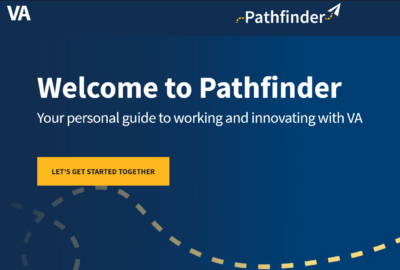40 members of US Digital Corps head to 13 agencies to improve services
In today's Federal Newscast, the Biden administration outlines its plan to maximize COVID-era IT modernization funds, and a study shows the brain injury CTE is rare...
- Forty new technologists are coming to help agencies improve their digital services. Thirteen agencies will welcome the first ever cohort for the U.S. Digital Corps. The fellows will work at places like the Cybersecurity and Infrastructure Security Agency and the Department of Veterans Affairs. The Biden administration launched the program last year as a cross-government effort to recruit early-career technologists. The Digital Corps received more than 1,000 applications in one week and offered 10 more positions than the initial plan.
- The Army is about to kick off a major business systems modernization effort. The Army’s Office of the Chief Information Officer wants to modernize and consolidate five enterprise resource planning (ERP) systems and 150 support systems. Raj Iyer, the Army’s CIO, said the service will release later this summer a call for white papers under an OTA. That will lead to several prototypes over the next 12-to-18 months to help determine what commercial products can meet the service’s needs. Iyer said this business systems initiative will be done using an agile approach and could take up to 10 years to complete. The Army is asking for $1.4 billion in fiscal 2023 to support those 5 ERPs and 150 support systems.
- The Department of Veterans Affairs is trying to streamline how contractors interact with the department. Last month it announced the Pathfinder site, a new digital one-stop shop for contractors looking to work with the VA. On June 7, that website officially went live. VA also has a portal to help developers interface with VA services. A third shares style and design guidelines to promote consistency. (Federal News Network)
- Federal Executive Boards prioritized emergency preparedness and workforce development for agencies. FEBs across the country provided training for 23,000 federal employees over the last year. The training covered areas like managing virtual teams and preparing for retirement. The boards also hosted 36 workshops and six exercises, and helped agencies collaborate with state and local governments. That’s all to better prepare for emergencies like pandemics, natural disasters and cyberattacks. The Office of Personnel Management said the boards made significant progress in 2021 to improve cross-agency collaboration.
- Military personnel are at risk for some brain injuries, but not the same kind as football players, according to a new study. A limited study of service members’ brains found the chronic traumatic encephalopathy may be rare in military personnel. CTE is most famous for being linked to sports like football and boxing and is caused by repeated sub-concussive hits. About 4% of the 225 brains studied had the disease, according to a report in the New England Journal of Medicine. All of those service members had a history of playing in contact sports. The military is still increasingly concerned about brain injuries caused by being in blast zones and from using heavy weaponry.
- The Pentagon is moving forward with a plan to build a mobile prototype nuclear reactor that may be an alternative energy source in some locations. The Defense Department chose BWTX Advanced Technologies and X-energy to build the prototype for what it calls Project Pele. The contract could be worth as much as $300 million, with a delivery date in 2024.
- The Biden administration is outlining its plan to maximize COVID-era IT modernization funds from Congress. The Office of Management and Budget plans to spend what’s left of the $200 million Congress gave its IT Oversight and Reform Account to hire technical experts who can lead modernization projects across government. The General Services Administration will use what’s left of the $150 million that went to its Federal Citizen Services Fund to improve customer experience across several dozen agencies and programs designated as High-Impact Service Providers. The Technology Modernization Fund will use its remaining funds, in part, to identify new opportunities for shared services across government. (Federal News Network)
- The IRS is suffering from more and more impersonation scams. The Treasury Inspector General for Tax Administration finds that between October 2013 and March 2022, more than 16,000 victims have lost $85 million to these IRS impersonation scams. The IG said scammers usually try to obtain sensitive taxpayer information or coerce victims into buying gift cards. TIGTA said it has initiated 893 impersonation scam-related investigations. These efforts have resulted in 300 individuals being charged in federal court. Of those, 197 individuals have been sentenced collectively to more than 910 years’ imprisonment and ordered to pay more than $224 million in restitution.
- An advisory panel is pushing for a review of how the Department of Homeland Security handles immigration records requests. The Freedom of Information Act Advisory Committee is recommending Congress fund an independent assessment of how DHS handles FOIA requests for Alien Files. So-called A-Files are one of the largest categories of FOIA requests. They are crucial for those requesting immigration benefits or seeking to defend themselves in court proceedings. The FOIA Advisory Committee’s latest report also recommends U.S. Citizenship and Immigration Services establish a fast-track processing alternative for A-File requests. (Federal News Network)
- Agencies are inconsistently addressing the risks brought on by using time and materials or labor hours type contracts. The Government Accountability Office found agencies spent $139 billion between 2017 and 2021 using these contracts, which require the government to play a more active role in managing costs. Auditors said agencies — such as the Army and the Department of Homeland Security — have taken steps to switch T&M contracts to firm fixed price-type contracts to reduce risk. Meanwhile other agencies, like the Air Force, the Department of State and the Social Security Administration, have increased their use of T&M type contracts.
- The General Services Administration is taking the next steps to transition to an electric fleet. The GSA launched 19,000 new telematic devices to collect data on vehicle usage, trip duration, idling time and fuel use in its automobile fleet. The data will help the agency understand which vehicles can be replaced with electric ones. The new devices are an addition to the over 60,000 already in use. The GSA is working with other vehicle manufacturers to put the telematic devices in more models.
Copyright © 2025 Federal News Network. All rights reserved. This website is not intended for users located within the European Economic Area.
Peter Musurlian
Peter Musurlian is a producer at Federal News Network.
Follow @PMusurlianWFED
Related Stories
OMB outlines plan to maximize COVID-era IT modernization funds from Congress
FOIA advisers recommend independent review into how DHS handles immigration record requests
Related Topics
All News
Cybersecurity
Cybersecurity and Infrastructure Security Agency
Department of Homeland Security
electric vehicles
Federal Drive
Federal Newscast
FOIA requests
General Services Administration
Government Accountability Office
immigration
IRS
Technology
Tom Temin
Treasury Inspector General for Tax Administration
US Digital Corps
Veterans Affairs
Workforce






